
The Boston terrier is known as the American Gentleman and is an intelligent, lively, affectionate and all-out loveable dog who sports a short, smooth, fine coat that resembles a tuxedo. He combines his enthusiasm from his terrier ancestors with his gentle sweetness and good sense from his bulldog ancestors to show he’s a lover, not a fighter.
The Boston’s enthusiastic and sometimes stubborn nature paired with bursts of hyperactivity can get him into trouble from time to time, but it takes just one upward glance with those big, brown eyes to melt your heart. He loves to occasionally clown around for attention but is generally well-mannered indoors and especially loves snuggling with his people.
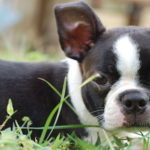

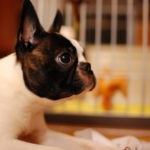
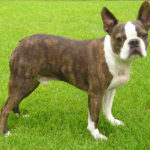
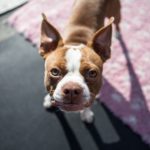
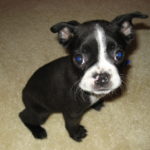
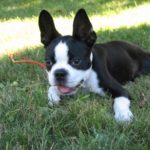
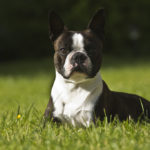
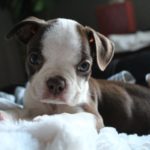
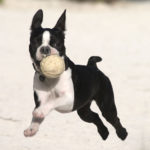
Did You Know…?
- Silent film star Pola Negri, Rudolph Valentino’s lover, reportedly took her Boston terrier, Patsy, with her everywhere, including restaurants and nightclubs. When one of the restaurants refused to let her enter with her beloved dog, she stormed out, shouting “No Patsy, no Pola. Goodbye forever!” Another famous person who had a Boston terrier named Patsy was gossip columnist Louella Parsons.
- The Boston terrier is a native American breed and was named after the city where it first originated.
- Like their English bulldog relatives, early Boston terriers were bred for pit fighting and were much larger and heavier than they are today, weighing up to 44 pounds. (Boston terriers today weigh between 10 and 25 pounds.) As dog fighting fell out of fashion and legality, the breed transformed into the smaller companion animal we know today.
- Boston terriers are less excitable than other terrier breeds, probably because of their bulldog genes.
- The Boston terrier was chosen as the bicentennial dog of the United States in 1976.
- The Boston terrier is the official state dog of Massachusetts.
- Bostons aren’t big droolers, but they do tend to be big snorers, and are prone to grunting and snorting, too, because of the size and shape of their muzzles.
- Boston terriers are sometimes confused with French bulldogs because they look alike. You can tell them apart by their ears—Boston terriers have pointed ears while French bulldogs have rounded ones.
- President Gerald Ford had two Boston terriers named Fleck and Spot. Warren G. Harding had one called Hub.
- Many Boston terriers need a C-section when giving birth. This is due to their large head size.
- America’s first war dog was a Boston terrier named Sergeant Stubby who served for 18 months as a member of the 26th Infantry Division of the U.S. Army. He located wounded soldiers, detected poisonous gas attacks, and was responsible for capturing a German spy. Stubby achieved the rank of Sergeant and was celebrated as a national hero.
- The Boston terrier had a name change early in its history. In 1889 about 30 fanciers organized the American Bull Terrier Club. They called the dogs round heads or bull terriers. The nickname prompted some opposition because a different breed was already called the bull terrier and it had a much longer face. By 1891 the club had changed their name to Boston Terrier Club of America, using the city of the breed’s origin instead.
- Boston terriers have a misleading name. Despite being called Boston terriers, they’re technically not terriers at all—at least they’re excluded from the terrier group on the AKC website.
- A Boston terrier named Phiz was given to Helen Keller by her classmates at Radcliffe College. Although the dog was wary of strangers, it’s said that the two hit it off immediately.
Quick Stats
- Dog Breed Group: Companion dogs, non-sporting group
- Height: 15 to 17 inches tall
- Weight: between 10 and 25 pounds
- Lifespan: 13 to 15 years
Breed Characteristics
Adaptability

Adapts Well to Apartment Living: 5/5
Good for First-time Owners: 4.5/5
Sensitivity Level: 4.5/5
Tolerates Being Alone: 2.5/5
Tolerates Cold Weather: 2.5/5
Tolerates Hot Weather: 2/5
All Around Friendliness

Affectionate with Family: 5/5
Kid-Friendly: 5/5
Dog-Friendly: 4.5/5
Friendly Toward Strangers: 4/5
Health and Grooming

Amount of Shedding: 1.5/5
Drooling Potential: 1/5
Easy to Groom: 5/5
General Health: 4/5
Potential for Weight Gain: 3/5
Size: 2/5
Trainability

Easy to Train: 4/5
Intelligence: 4/5
Tendency to Bark or Howl: 2.5/5
Exercise Needs

Energy Level: 4/5
Intensity: 4.5/5
Exercise Needs: 3/5
Potential for Playfulness: 5/5
 History
History
The Boston terrier is a true American creation, and unlike many breeds’ origins, the Boston terrier’s beginning is documented. One story suggests that coachmen of wealthy families crossed bulldogs and the now-extinct white English terrier to create a new breed of fighting dogs. Another story suggests that a man named Robert C. Hooper imported a Bulldog/English Terrier mix from England that he named Judge.
While it’s not clear which story he comes from, there was an actual dog named Judge who was the direct ancestor of the Boston terrier as we know it today. He was bred with a 20-pound white bitch named Burnett’s Gyp (or Kate) who belonged to a man named Edward Burnett of Southboro, Massachusetts. They had one male puppy named Well’s Eph.
Well’s Eph was an unattractive dog, but his other traits were admired, and Hooper and his friends had him widely bred. One of his matings was to a female named Tobin’s Kate who weighed 20 pounds, had a short head, and was a golden brindle color. It’s assumed that their offspring were bred to one or more French Bulldogs to create the Boston terrier as we know it today.
The little dogs with the round heads and screw tails were first known as round heads, bullet heads, Boston bulldogs, American terriers, or bull terriers. In 1889 about 30 fanciers organized the American Bull Terrier Club. They called the dogs round heads or bull terriers. The nickname prompted opposition because a different breed was already called the bull terrier and it had a much longer face. By 1891 the club had changed their name to Boston Terrier Club of America, using the city of the breed’s origin instead.
In 1893 the breed was recognized and admitted to the stud book by the American Kennel Club (AKC), less than 20 years after the breed was born. The Boston terrier was one of the first Non-Sporting dogs bred in the United States and was the first of 10 made-in-America breeds currently recognized by the AKC.
Though at first the Boston terrier’s colors were not included in the breed standard, the inconsistency came to a stop in the early 1900s when the breed’s distinctive markings and colors were meticulously written into the standard, making them an essential feature. The coloring and the Boston terrier’s gentle disposition earned it the nickname, “American Gentleman.”
Boston terriers quickly became popular in the United States, becoming the most popular breed in the U.S., in 1915, 1920, and 1930. It remained in the top ten most popular breeds until the 1960s. Today, the Boston ranks 21st among all the breeds registered by the AKC, down from 18th in 2000. In 1976, the Boston terrier was chosen as the bicentennial dog of the United States and in 1979 he was named the official state dog of Massachusetts.
Size
 Both male and female Boston terriers are 15 to 17 inches tall and weigh between 10 and 25 pounds.
Both male and female Boston terriers are 15 to 17 inches tall and weigh between 10 and 25 pounds.
Appearance
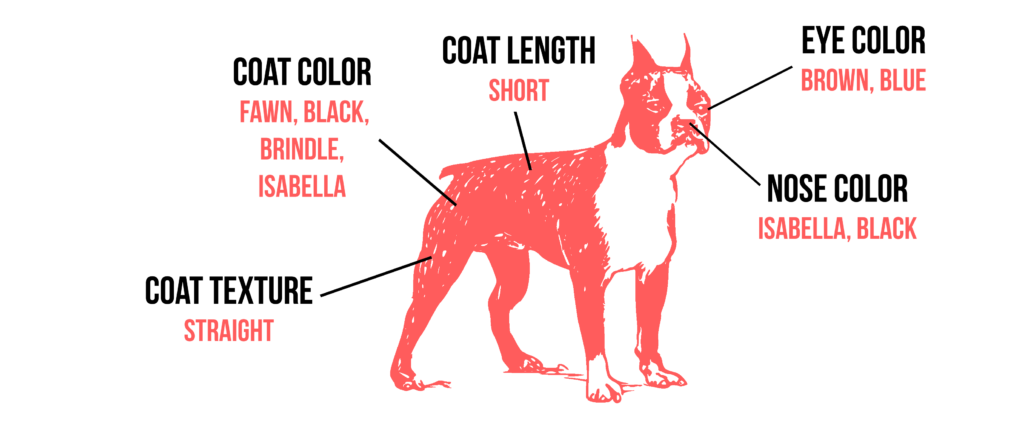 The Boston terrier is permanently on the best-dressed list due to its short, smooth, fine coat that comes in three colors: black (best-known variety), seal (black with a reddish cast in the sunlight), or brindle, all with a white muzzle, face blaze, and chest, giving him the look of wearing a tuxedo.
The Boston terrier is permanently on the best-dressed list due to its short, smooth, fine coat that comes in three colors: black (best-known variety), seal (black with a reddish cast in the sunlight), or brindle, all with a white muzzle, face blaze, and chest, giving him the look of wearing a tuxedo.
Boston terriers don’t come in solid colors such as black, gray, liver, or white, so be wary of breeders who try to sell you one of these dogs because of the “rare” color. Not sticking to the breed standard is a sign of a low-quality breeder.
These dogs are short-headed, compactly built, short-tailed, and well-balanced. Their expression is alert and kind, indicating a high degree of intelligence, and the overall impression should be one of determination, strength, style, and activity.
They have a lovable, wrinkle-free mug with a square jaw line and upright ears that are sometimes cropped. The nose is black and the eyes are set wide apart and are large, round, and dark in color. They should never have any trace of blue. The chest is deep and the body should appear short.
Boston’s bodies are short and well-knit, the limbs strong and neatly turned, and the tail is short. The forelegs are straight in bone with short, strong pasterns. The dewclaws may be removed. The feet are small, round and compact, with well-arched toes and short nails.
The thighs are strong and well-muscled, the hocks are short to the feet, and the feet are small and compact with short nails. The Boston’s carriage should be easy and graceful, with a clean-cut overall appearance.
Behavior
Personality
Boston terriers are very individualistic, some are high-spirited and clownish, while others are calm and dignified. Some are stubborn characters, while others are sweet and gentle. In general, though, the Boston terrier lives up to his nickname, the American Gentleman, in every form of the word. He is lively, smart, and affectionate and has a gentle, even temperament. He combines his enthusiasm from his terrier ancestors with his gentle sweetness and good sense from his bulldog ancestors to show he’s a lover, not a fighter.
They’re also very intelligent, and some would even say too much so. Their lively and sometimes stubborn natures paired with bursts of hyperactivity can get them into trouble. But it takes just one upward glance with those big, dark eyes to melt your heart.
Boston terriers also have a sly sense of humor and love to clown around to get some attention. They are well-mannered indoors, but love to be a little saucy when the chance arises. They love to be with people, especially when it means snuggling on a couch or bed. Expect them to be excited when visitors come to call, but realize that they’ll calm down once the enthusiastic greeting has been given.
Bostons can entertain themselves, especially with a favorite toy or two, but they would much rather be doing things with their people. They can adapt to your schedule, but leaving them alone all the time is not the best idea. Bostons are love bugs and need a family who wants and enjoys their company.
As with all dogs, socializing your Boston terrier puppy from day one is an absolute must. Exposure to many different people, sights, sounds, and experiences will help your puppy grow up to be a well-rounded dog. Because these dogs can be a little stubborn, persistence and consistency are definite musts while training.
Bostons are devoted and sensitive to their owner’s wishes, but this sensitivity makes it so they don’t do well with harsh training or being yelled at. Positive reinforcement is the best way to train this breed. Crate training is highly recommended as housetraining often comes slowly (4 to 6 months) for these dogs.
Since this breed is very individualistic, training may come more easily to some dogs than others. If your dog is struggling with training, find what motivates him, whether it be food, praise, or a favorite toy, and use that to help.
Some Boston terriers have a reputation for being excessively active. Know that this is not typical of the breed and a well-bred, well-socialized Boston will be outgoing and playful within reason, never obnoxiously demanding of time and attention. Boston terriers are also sometimes protective of their owners, and some may bark a lot, though the majority don’t.
Children & Other Pets
Bostons love kids and also do well with the elderly. But as with all dogs, teach kids how to treat dogs respectfully and always supervise playtime, especially when young children are involved. The Boston does really well with other pets and animals in general. If you work all day, it can be nice to have a second Boston so they can keep each other company. They may also put on quite a show if they see a larger dog across the street, but they are seldom truly aggressive.
Health
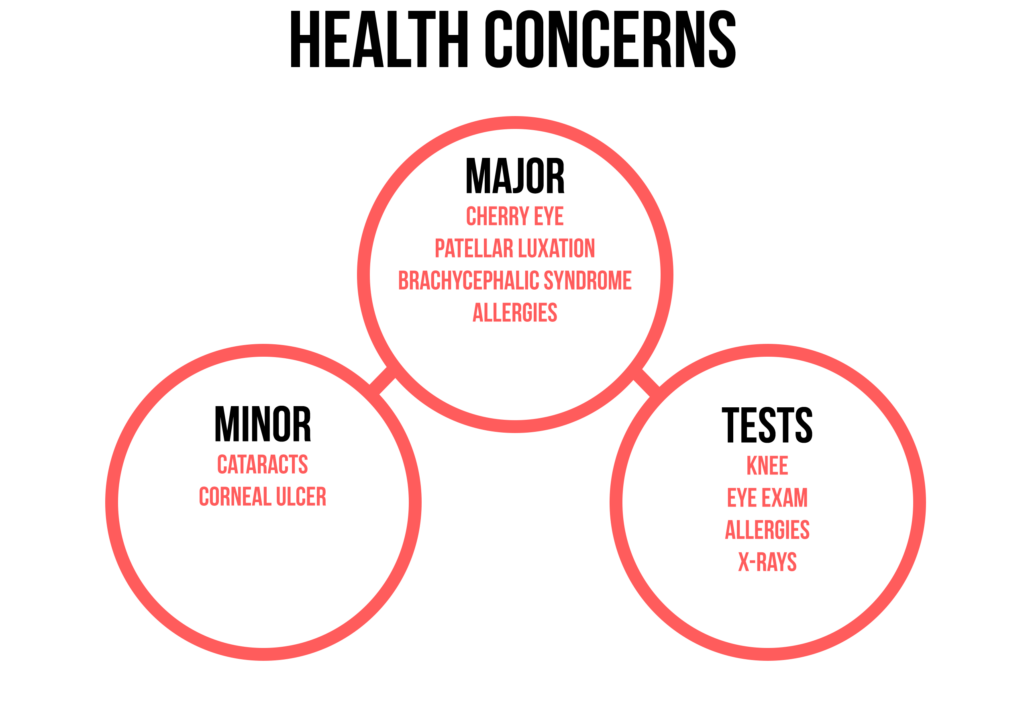 Provide your Boston with regular checkups, routine vaccinations, tests for intestinal parasites, heartworm prevention, and flea and tick control. Your vet should do regular dental checkups and care, and you should clean your dog’s teeth regularly at home as well.
Provide your Boston with regular checkups, routine vaccinations, tests for intestinal parasites, heartworm prevention, and flea and tick control. Your vet should do regular dental checkups and care, and you should clean your dog’s teeth regularly at home as well.
If you’re considering buying a Boston terrier, there are some potential health concerns that you should be aware of. Bostons are a brachycephalic breed and their short face can make breathing more difficult than it is for long-nosed breeds, so they’re less tolerant of heat, exercise, and stress, all of which increase the need to breathe. Be sure to keep your dog cool in warm weather and avoid strenuous exercise.
Consult your veterinarian if your dog seems to overheat or become stressed easily and has noisy breathing or spits up foam. Pinched nostrils or an elongated soft palate (described in detail below) could be plaguing your pup. Anesthesia is also riskier in short-faced dogs, so be sure your veterinarian is experienced with such breeds should your Boston need to be anesthetized.
There’s no guarantee that your dog will get any or all of these conditions listed below, but it’s important to be aware of them if you’re considering this breed.
Allergies
Boston terriers can suffer from a variety of allergies, ranging from contact allergies to food allergies that can cause terribly itchy skin. If your Boston is licking his paws or rubbing his face a great deal, he may have an allergy which can be diagnosed by your vet.
Brachycephalic Airway Syndrome (BAS)
Owner’s with smoosh-faced dogs should know about BAS. It can be caused by a myriad of problems including narrow nostrils (stenotic nares), an elongated soft palate, a narrower trachea than usual, and sacs inside the voice box or larynx. These can narrow your dog’s airway, making breathing difficult.
BAS puts strain on the heart and can make any exertion exhausting for your dog. It can also cause a laryngeal collapse, which means a partial or total obstruction of airflow. Though Boston terriers often grunt and snort, sometimes these sounds can indicate one or more symptoms of BAS. Heat and humidity can make symptoms worse. Treatment varies depending on the severity of the condition but includes oxygen therapy as well as surgery to widen nostrils or shorten palates.
Cataracts
This condition is a clouded film over the eye lens. Boston terriers are prone to get juvenile cataracts, which develop when the puppy is between eight weeks and 12 months of age, or adult cataracts. Sometimes you can see juvenile cataracts, but other times they can only be seen during a CERF (Canine Eye Registration Foundation) test. When purchasing a Boston terrier puppy, ask the breeder if it’s been tested for juvenile cataracts.
Cherry Eye
Cherry eye occurs when the gland of the third eyelid moves down or forward to where it becomes visible. This condition is believed to be genetic in origin. It frequently occurs in dogs that are less than a year old. Veterinarians may reposition the gland surgically to its original site at the base of the third eyelid or remove the prolapsed gland altogether.
Corneal Ulcers
A corneal ulcer occurs when deeper layers of the cornea are lost. If your dog’s eyes are tearing excessively, or it is squinting, there is a possibility of a corneal ulcer. Most often this condition happens to Bostons when their prominent eyes are scratched.
Deafness
A small, but significant amount of Boston terriers are partially or totally deaf. Learning this when the dog is young will help in the training and socialization process. Note that Bostons with white covering more than one-third of their heads and/or bodies tend to produce more deaf puppies. Responsible breeders should have puppies BAER tested to determine the status of the puppies’ ears before they go to new homes.
Elongated Soft Palate
The soft palate is the extension of the roof of the mouth. Elongated soft palates can obstruct airways and cause difficulty in breathing. The treatment for this condition is surgical removal of the excess palate.
Entropion
This condition occurs when the eyelids curl painfully inward. It causes pain and sometimes even eye loss, and treatment requires plastic surgery to fix the defect. If not treated, dogs with this condition can suffer for a lifetime with either chronic irritation, frequent infections, or corneal ulceration (from eyes too dry or eyelid hairs perpetually rubbing on the delicate cornea).
Epilepsy
The Boston Terrier Club conducted a health survey that covered the death of 109 Boston terriers. They found that 10 percent of surveyed Bostons had died from epilepsy. Epilepsy is a neurological disorder that can often result in seizures. This problem is often an inherited condition with seizures typically starting between six months and three years of age. Lifelong medication is usually necessary to keep seizures under control. If your dog has a seizure, carefully prevent him from injuring himself but don’t try to control his mouth or tongue! It won’t help and he might bite you by accident! Note the length of the seizure and call your vet or an emergency hospital.
Glaucoma
Glaucoma is defined as an imbalance of the fluid pressure within the eye. If this fluid can’t drain properly, the pressure in the eye builds and can cause permanent damage to some or all of the internal parts of the affected eye. Irreversible blindness can result if the damage is severe enough.
Heart Disease
Boston terriers are predisposed to certain heart problems. This is commonly due to a genetic predisposition toward valve deterioration and can often be heard as a heart murmur during an annual exam. If caught early on, prescribed medications can slow degeneration and increase lifespan. Regular exams, maintaining oral health, and weight management, are all preventative measures you can take to help your Boston be as healthy as possible.
Hemivertebrae
This condition is linked to the corkscrew tail which can lead to the failure in the development of the bones in the spine. Some dogs are asymptomatic, but others will show signs during puppyhood, such as impaired movement or a lack of coordination in the hind legs. Paralyzation is a possibility, and surgery is the only treatment.
Hip Dysplasia
This is an inherited disease that causes the hip joints to form improperly and leads to arthritis. The Orthopedic Foundation of America evaluated the hip X-rays of 270 Boston terriers and found 12 percent dysplastic—a very high number for a small breed. Signs include lameness in the hind legs or difficulty getting up from lying down. The arthritis can be treated, though surgery is sometimes considered in severe and life-limiting cases. Keep in mind that overweight dogs may develop arthritis years earlier than those of normal weight, causing undue pain and suffering.
Mast Cell Tumors (MCT)
Mast cell tumors (MCT) represent a cancer of a type of blood cell normally involved in the body’s immune response. MCT is the most common skin tumor in dogs; it can also affect other areas of the body, including the spleen, liver, gastrointestinal tract, and bone marrow. Pushing on the tumor can aggravate it, causing it to spore out and spread to other areas of the body.
Megaesophagus
Megaesophagus is a condition where peristalsis (the muscle movement that results in swallowing) fails to occur properly and the esophagus is enlarged. This causes a dog to regurgitate its undigested food. It differs from vomiting in that there generally is no advance warning that it will occur.
Patellar Luxation
Patellar Luxation is a common problem in small dogs. It’s caused when the patella (kneecap) is not properly lined up with the femur (thigh bone) and tibia (calf), or in other words, when the kneecap slips out of place. It can cause lameness in the leg or an abnormal gait in the dog. The disease is present at birth although the actual misalignment may not occur until later. The rubbing caused by patellar luxation can lead to arthritis. There are four grades of patellar luxation, the most severe possibly requiring surgery.
Health Clearances
For Boston terriers to be included in the Canine Health Information Center (CHIC) database, the Boston Terrier Club of America requires them to have a clearance from the Canine Eye Registry Foundation (CERF), a patella evaluation from the Orthopedic Foundation for Animals, and a hearing evaluation based on the BAER test from either OFA or the Institute for Genetic Disease Control in Animals at UC-Davis (GDC). You can search the OFA and CHIC websites to see if a puppy’s parents are listed.
Maintenance
 Care
Care
Boston terriers are lively dogs but don’t require a substantial amount of exercise. They’re relatively mellow indoors and well suited for apartments and city-living. They enjoy walks and playing in the yard or at the park, but are definitely indoor dogs and should never be housed outside. Keep in mind that Bostons can’t handle the heat or cold very well.
They are also very social dogs and love spending time with their people. They need a family who wants and enjoys their company.
Feeding
It’s recommended that you give your Boston terrier between 1/2 to 1-1/2 cups of high-quality dry food a day, divided into two meals. Since all dogs are different, the amount will vary depending on your Boston’s size, age, build, metabolism and activity level.
Be aware that Boston terriers can be gluttonous about their food. Monitor their condition and make sure they don’t become overweight. They can also be prone to flatulence, which may be related to their diet. Feed a high-quality food to reduce the likelihood of this problem.
Grooming
The Boston has a short, smooth coat that is easy to groom and doesn’t shed heavily. Brush him weekly to remove dead hair and keep the skin healthy.
He also doesn’t have a doggie odor and shouldn’t need a bath more often than every couple months. As with all dogs, trim his toenails every few weeks so they don’t get caught on things and painfully tear. Brush his teeth frequently for good dental health.
Many Boston terrier owners will also carry eye drops to flush out dust or debris that might float into their dog’s eyes. This can be especially true if they live in big cities. Ears should be checked regularly to avoid a buildup of wax and debris which can result in an infection.
Questions
What are the traits of a Boston terrier?
Known as the “American Gentleman,” the Boston terrier is lively, smart, and affectionate with a gentle, even temperament. They can be a little stubborn, so persistence and consistency are necessary when training.
What is a Boston terrier made of?
A Boston terrier is a mix between a bulldog and the now extinct white English terrier.
What kind of health problems do Boston Terriers have?
Though it’s unlikely that a healthy member of the Boston terrier breed will get any or all of these health problems, it’s important to know that Bostons are at risk for BAS, allergies, numerous eye disorders (such as cataracts, corneal ulcers, and glaucoma), deafness, epilepsy, heart disease, hip dysplasia, Mast Cell Tumors (MCT), and patellar luxation.
Resources
Rescue Organizations/Groups
- Alabama Boston Terrier Rescue
- Boston Buddies (Southern California)
- Boston Terrier Club of CT Rescue
- Boston Terrier Rescue of North Carolina
- Boston Terrier Rescue of North Texas
- Boston Terrier Rescue of West Virginia
- MidAmerica Boston Terrier Rescue
- Midwest Boston Terrier Rescue
- Nebraska Boston Terrier Rescue
- Northeast Boston Terrier Rescue
- Wonderdog Rescue (Northern California)
Breed Organizations
Top Breeders
- Painted Bostons – Shoals, Indiana
-
Circle J Boston Terriers – Tyler, Alabama
-
Savanas Boston Terriers – Schriever, Louisiana
-
Marti Acres – Lamar, Missouri
-
Our Brindle Bostons and Japanese Chin – Lexington, Oklahoma
-
Atlantis Boston Terriers – Palm Harbor, Florida
-
Bremer Kennels – Azle, Texas
-
Kayshappytails – Birch Tree, Missouri
-
Puppy-Tailz – West Plains, Missouri
- Juwell’s Bostons – Nunn, Colorado
- Heavenly Bostons – Magna, Utah
- Maximum Companion – Mira Loma, California
- Campbell Clan Bostons – Sacramento, California
- Best Boston Terrier Puppies – Tennessee
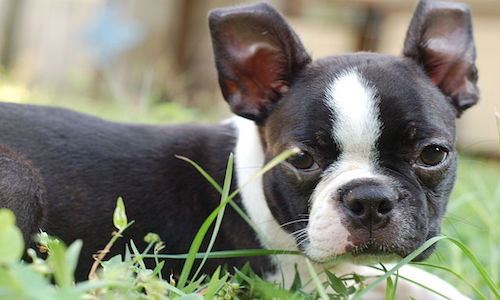
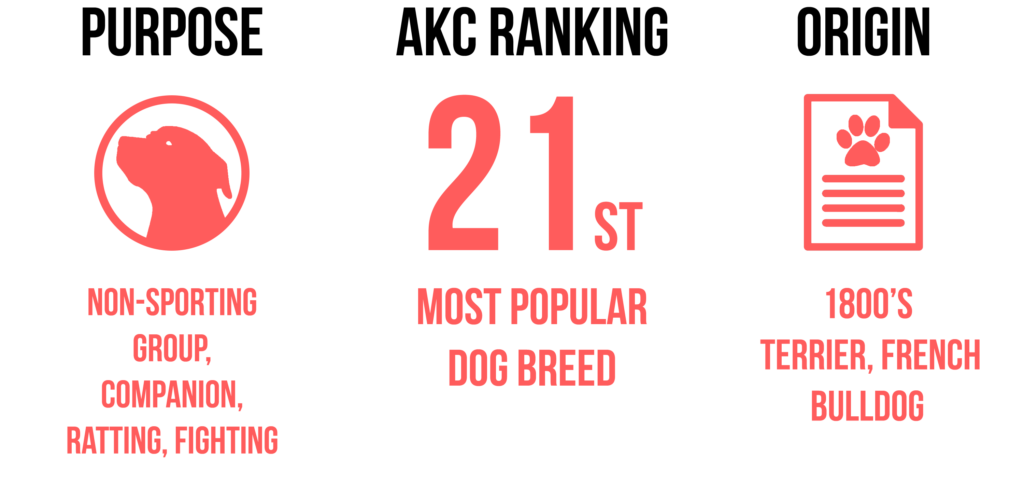 History
History Care
Care